NUR3030: ATSI Health Report - Social and Emotional Wellbeing
VerifiedAdded on 2022/09/09
|10
|2283
|27
Report
AI Summary
This report critically analyzes the social and emotional wellbeing of Aboriginal and Torres Strait Islander (ATSI) peoples, contrasting it with Western definitions of mental health. It explores the historical factors impacting ATSI wellbeing, including loss of land and cultural disruption, and examines the evolution of Aboriginal Medical Services (AMS) and their alignment with primary health care principles. The report details how social and emotional wellbeing is applied within Aboriginal Community-Controlled Health Services (ACCHS), highlighting the importance of culturally safe and accessible healthcare. The report emphasizes the holistic view of health within ATSI communities, integrating mental, spiritual, and cultural dimensions, and advocates for policies that address the social determinants of health to improve ATSI wellbeing.
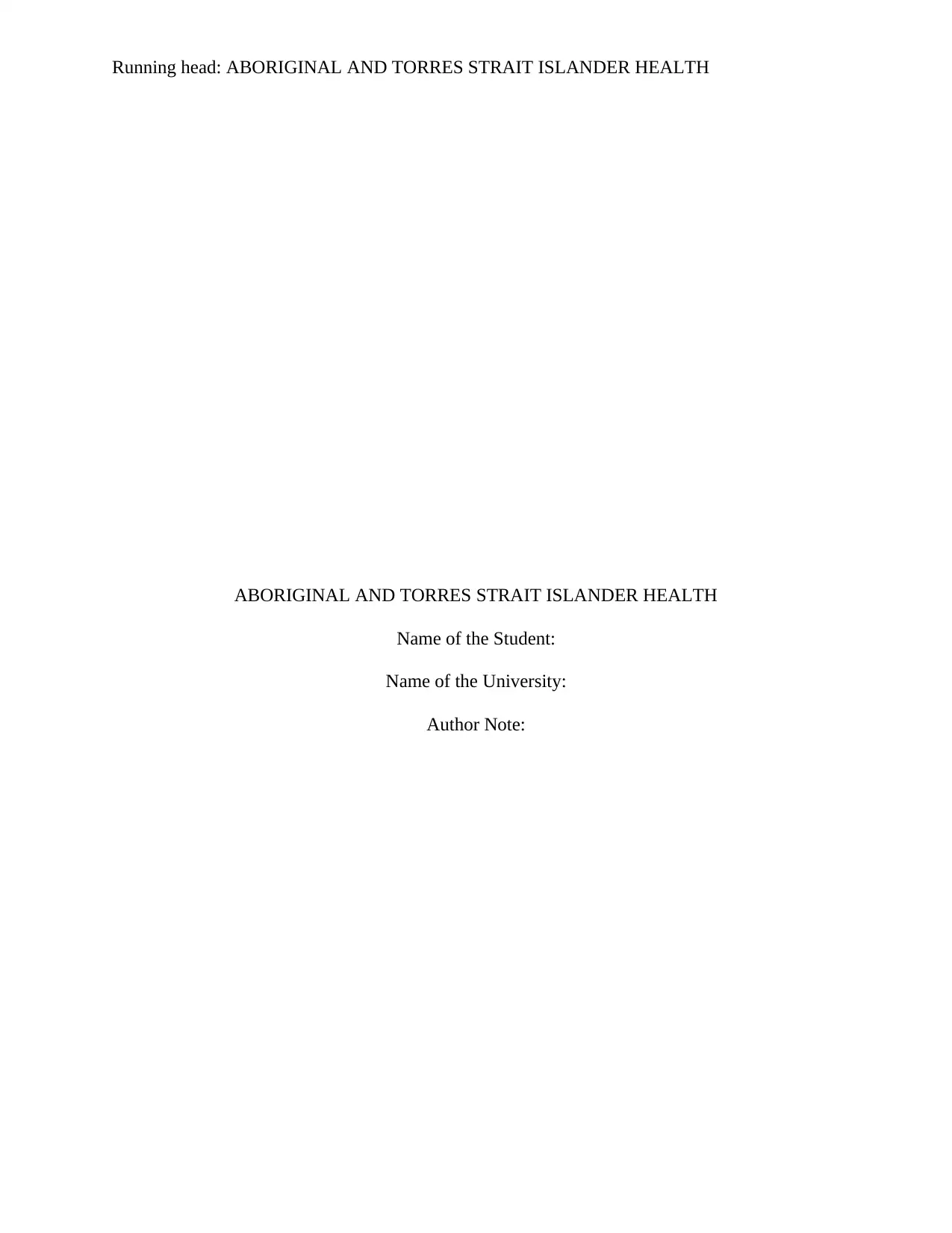
Running head: ABORIGINAL AND TORRES STRAIT ISLANDER HEALTH
ABORIGINAL AND TORRES STRAIT ISLANDER HEALTH
Name of the Student:
Name of the University:
Author Note:
ABORIGINAL AND TORRES STRAIT ISLANDER HEALTH
Name of the Student:
Name of the University:
Author Note:
Paraphrase This Document
Need a fresh take? Get an instant paraphrase of this document with our AI Paraphraser
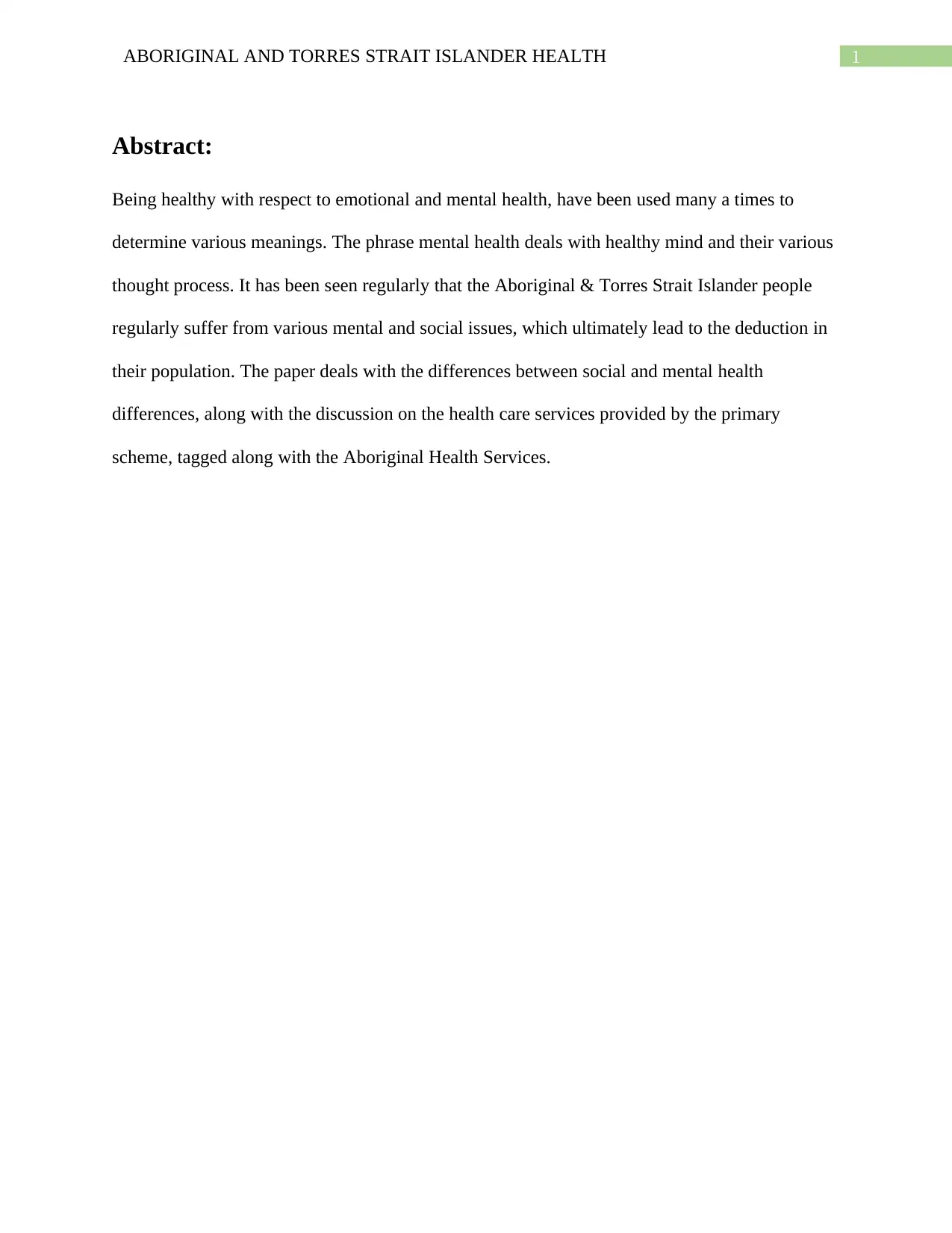
1ABORIGINAL AND TORRES STRAIT ISLANDER HEALTH
Abstract:
Being healthy with respect to emotional and mental health, have been used many a times to
determine various meanings. The phrase mental health deals with healthy mind and their various
thought process. It has been seen regularly that the Aboriginal & Torres Strait Islander people
regularly suffer from various mental and social issues, which ultimately lead to the deduction in
their population. The paper deals with the differences between social and mental health
differences, along with the discussion on the health care services provided by the primary
scheme, tagged along with the Aboriginal Health Services.
Abstract:
Being healthy with respect to emotional and mental health, have been used many a times to
determine various meanings. The phrase mental health deals with healthy mind and their various
thought process. It has been seen regularly that the Aboriginal & Torres Strait Islander people
regularly suffer from various mental and social issues, which ultimately lead to the deduction in
their population. The paper deals with the differences between social and mental health
differences, along with the discussion on the health care services provided by the primary
scheme, tagged along with the Aboriginal Health Services.
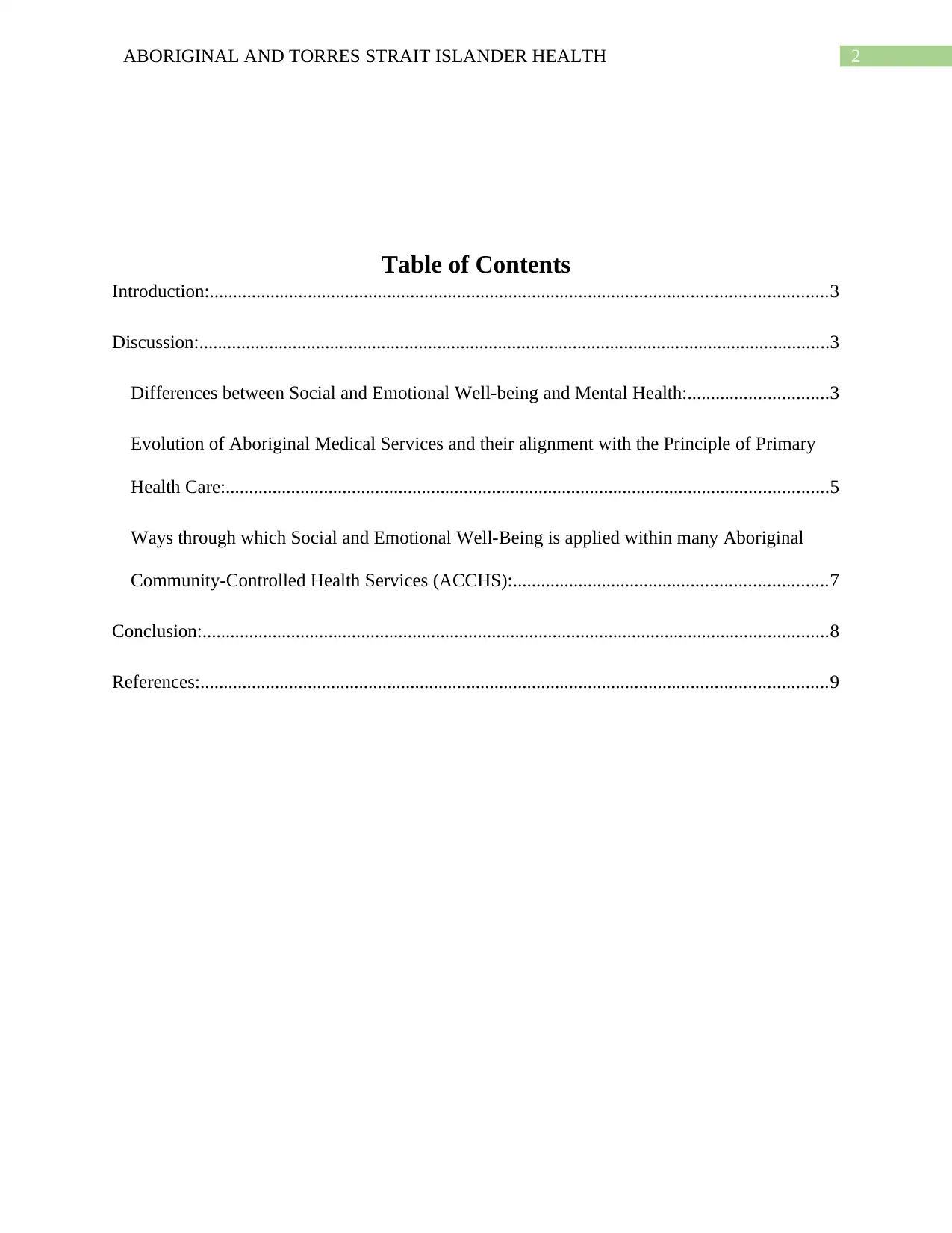
2ABORIGINAL AND TORRES STRAIT ISLANDER HEALTH
Table of Contents
Introduction:....................................................................................................................................3
Discussion:.......................................................................................................................................3
Differences between Social and Emotional Well-being and Mental Health:..............................3
Evolution of Aboriginal Medical Services and their alignment with the Principle of Primary
Health Care:.................................................................................................................................5
Ways through which Social and Emotional Well-Being is applied within many Aboriginal
Community-Controlled Health Services (ACCHS):...................................................................7
Conclusion:......................................................................................................................................8
References:......................................................................................................................................9
Table of Contents
Introduction:....................................................................................................................................3
Discussion:.......................................................................................................................................3
Differences between Social and Emotional Well-being and Mental Health:..............................3
Evolution of Aboriginal Medical Services and their alignment with the Principle of Primary
Health Care:.................................................................................................................................5
Ways through which Social and Emotional Well-Being is applied within many Aboriginal
Community-Controlled Health Services (ACCHS):...................................................................7
Conclusion:......................................................................................................................................8
References:......................................................................................................................................9
⊘ This is a preview!⊘
Do you want full access?
Subscribe today to unlock all pages.

Trusted by 1+ million students worldwide
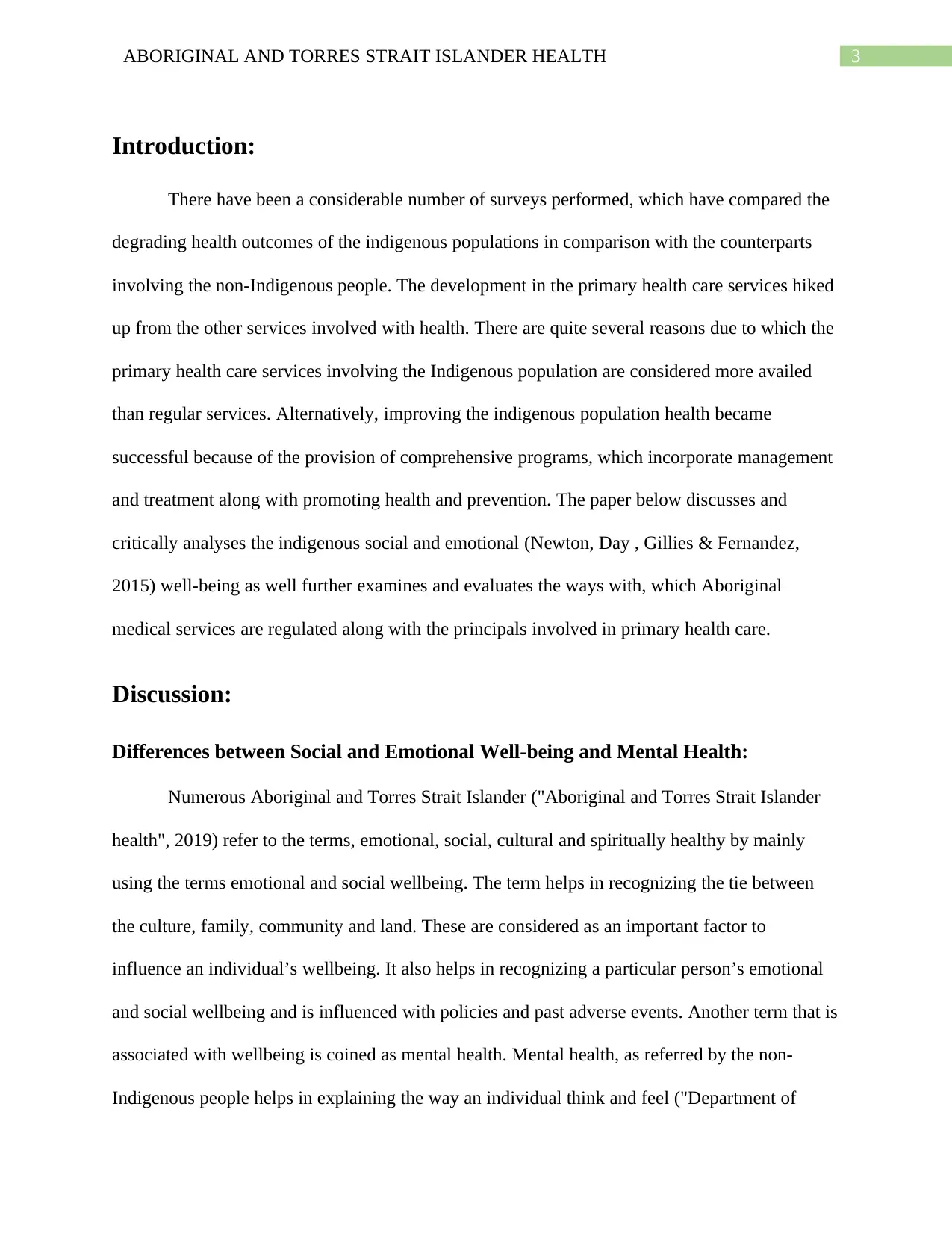
3ABORIGINAL AND TORRES STRAIT ISLANDER HEALTH
Introduction:
There have been a considerable number of surveys performed, which have compared the
degrading health outcomes of the indigenous populations in comparison with the counterparts
involving the non-Indigenous people. The development in the primary health care services hiked
up from the other services involved with health. There are quite several reasons due to which the
primary health care services involving the Indigenous population are considered more availed
than regular services. Alternatively, improving the indigenous population health became
successful because of the provision of comprehensive programs, which incorporate management
and treatment along with promoting health and prevention. The paper below discusses and
critically analyses the indigenous social and emotional (Newton, Day , Gillies & Fernandez,
2015) well-being as well further examines and evaluates the ways with, which Aboriginal
medical services are regulated along with the principals involved in primary health care.
Discussion:
Differences between Social and Emotional Well-being and Mental Health:
Numerous Aboriginal and Torres Strait Islander ("Aboriginal and Torres Strait Islander
health", 2019) refer to the terms, emotional, social, cultural and spiritually healthy by mainly
using the terms emotional and social wellbeing. The term helps in recognizing the tie between
the culture, family, community and land. These are considered as an important factor to
influence an individual’s wellbeing. It also helps in recognizing a particular person’s emotional
and social wellbeing and is influenced with policies and past adverse events. Another term that is
associated with wellbeing is coined as mental health. Mental health, as referred by the non-
Indigenous people helps in explaining the way an individual think and feel ("Department of
Introduction:
There have been a considerable number of surveys performed, which have compared the
degrading health outcomes of the indigenous populations in comparison with the counterparts
involving the non-Indigenous people. The development in the primary health care services hiked
up from the other services involved with health. There are quite several reasons due to which the
primary health care services involving the Indigenous population are considered more availed
than regular services. Alternatively, improving the indigenous population health became
successful because of the provision of comprehensive programs, which incorporate management
and treatment along with promoting health and prevention. The paper below discusses and
critically analyses the indigenous social and emotional (Newton, Day , Gillies & Fernandez,
2015) well-being as well further examines and evaluates the ways with, which Aboriginal
medical services are regulated along with the principals involved in primary health care.
Discussion:
Differences between Social and Emotional Well-being and Mental Health:
Numerous Aboriginal and Torres Strait Islander ("Aboriginal and Torres Strait Islander
health", 2019) refer to the terms, emotional, social, cultural and spiritually healthy by mainly
using the terms emotional and social wellbeing. The term helps in recognizing the tie between
the culture, family, community and land. These are considered as an important factor to
influence an individual’s wellbeing. It also helps in recognizing a particular person’s emotional
and social wellbeing and is influenced with policies and past adverse events. Another term that is
associated with wellbeing is coined as mental health. Mental health, as referred by the non-
Indigenous people helps in explaining the way an individual think and feel ("Department of
Paraphrase This Document
Need a fresh take? Get an instant paraphrase of this document with our AI Paraphraser
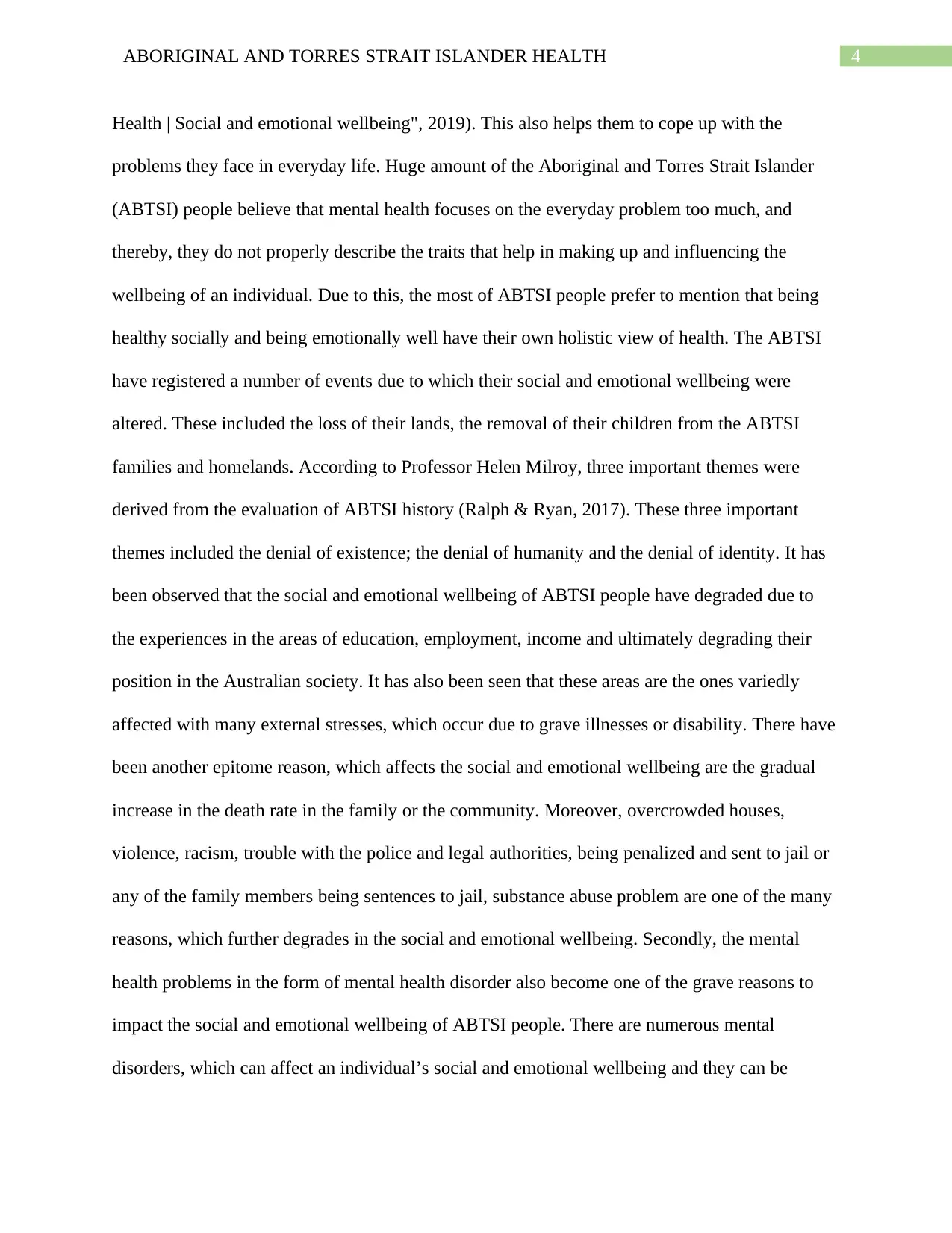
4ABORIGINAL AND TORRES STRAIT ISLANDER HEALTH
Health | Social and emotional wellbeing", 2019). This also helps them to cope up with the
problems they face in everyday life. Huge amount of the Aboriginal and Torres Strait Islander
(ABTSI) people believe that mental health focuses on the everyday problem too much, and
thereby, they do not properly describe the traits that help in making up and influencing the
wellbeing of an individual. Due to this, the most of ABTSI people prefer to mention that being
healthy socially and being emotionally well have their own holistic view of health. The ABTSI
have registered a number of events due to which their social and emotional wellbeing were
altered. These included the loss of their lands, the removal of their children from the ABTSI
families and homelands. According to Professor Helen Milroy, three important themes were
derived from the evaluation of ABTSI history (Ralph & Ryan, 2017). These three important
themes included the denial of existence; the denial of humanity and the denial of identity. It has
been observed that the social and emotional wellbeing of ABTSI people have degraded due to
the experiences in the areas of education, employment, income and ultimately degrading their
position in the Australian society. It has also been seen that these areas are the ones variedly
affected with many external stresses, which occur due to grave illnesses or disability. There have
been another epitome reason, which affects the social and emotional wellbeing are the gradual
increase in the death rate in the family or the community. Moreover, overcrowded houses,
violence, racism, trouble with the police and legal authorities, being penalized and sent to jail or
any of the family members being sentences to jail, substance abuse problem are one of the many
reasons, which further degrades in the social and emotional wellbeing. Secondly, the mental
health problems in the form of mental health disorder also become one of the grave reasons to
impact the social and emotional wellbeing of ABTSI people. There are numerous mental
disorders, which can affect an individual’s social and emotional wellbeing and they can be
Health | Social and emotional wellbeing", 2019). This also helps them to cope up with the
problems they face in everyday life. Huge amount of the Aboriginal and Torres Strait Islander
(ABTSI) people believe that mental health focuses on the everyday problem too much, and
thereby, they do not properly describe the traits that help in making up and influencing the
wellbeing of an individual. Due to this, the most of ABTSI people prefer to mention that being
healthy socially and being emotionally well have their own holistic view of health. The ABTSI
have registered a number of events due to which their social and emotional wellbeing were
altered. These included the loss of their lands, the removal of their children from the ABTSI
families and homelands. According to Professor Helen Milroy, three important themes were
derived from the evaluation of ABTSI history (Ralph & Ryan, 2017). These three important
themes included the denial of existence; the denial of humanity and the denial of identity. It has
been observed that the social and emotional wellbeing of ABTSI people have degraded due to
the experiences in the areas of education, employment, income and ultimately degrading their
position in the Australian society. It has also been seen that these areas are the ones variedly
affected with many external stresses, which occur due to grave illnesses or disability. There have
been another epitome reason, which affects the social and emotional wellbeing are the gradual
increase in the death rate in the family or the community. Moreover, overcrowded houses,
violence, racism, trouble with the police and legal authorities, being penalized and sent to jail or
any of the family members being sentences to jail, substance abuse problem are one of the many
reasons, which further degrades in the social and emotional wellbeing. Secondly, the mental
health problems in the form of mental health disorder also become one of the grave reasons to
impact the social and emotional wellbeing of ABTSI people. There are numerous mental
disorders, which can affect an individual’s social and emotional wellbeing and they can be
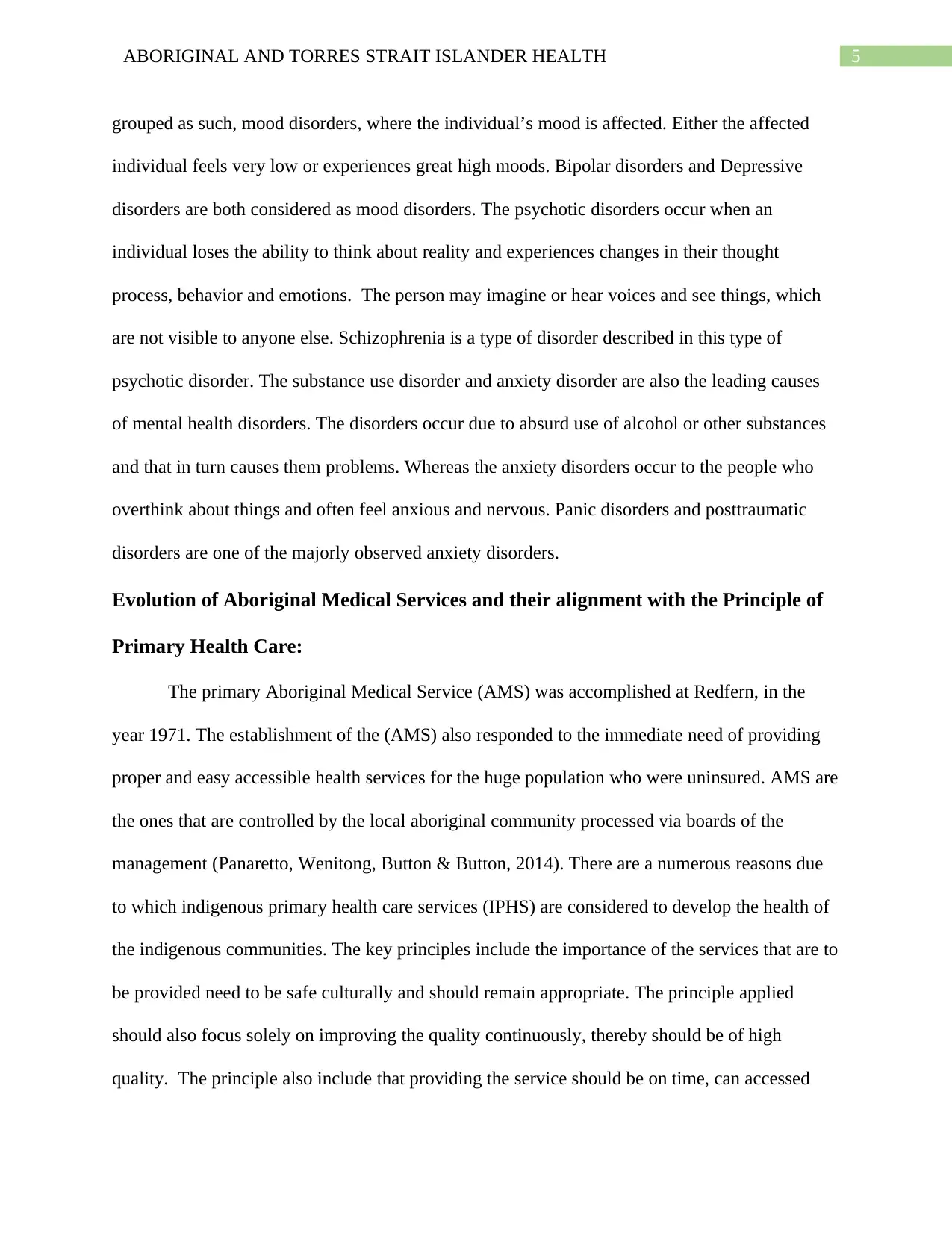
5ABORIGINAL AND TORRES STRAIT ISLANDER HEALTH
grouped as such, mood disorders, where the individual’s mood is affected. Either the affected
individual feels very low or experiences great high moods. Bipolar disorders and Depressive
disorders are both considered as mood disorders. The psychotic disorders occur when an
individual loses the ability to think about reality and experiences changes in their thought
process, behavior and emotions. The person may imagine or hear voices and see things, which
are not visible to anyone else. Schizophrenia is a type of disorder described in this type of
psychotic disorder. The substance use disorder and anxiety disorder are also the leading causes
of mental health disorders. The disorders occur due to absurd use of alcohol or other substances
and that in turn causes them problems. Whereas the anxiety disorders occur to the people who
overthink about things and often feel anxious and nervous. Panic disorders and posttraumatic
disorders are one of the majorly observed anxiety disorders.
Evolution of Aboriginal Medical Services and their alignment with the Principle of
Primary Health Care:
The primary Aboriginal Medical Service (AMS) was accomplished at Redfern, in the
year 1971. The establishment of the (AMS) also responded to the immediate need of providing
proper and easy accessible health services for the huge population who were uninsured. AMS are
the ones that are controlled by the local aboriginal community processed via boards of the
management (Panaretto, Wenitong, Button & Button, 2014). There are a numerous reasons due
to which indigenous primary health care services (IPHS) are considered to develop the health of
the indigenous communities. The key principles include the importance of the services that are to
be provided need to be safe culturally and should remain appropriate. The principle applied
should also focus solely on improving the quality continuously, thereby should be of high
quality. The principle also include that providing the service should be on time, can accessed
grouped as such, mood disorders, where the individual’s mood is affected. Either the affected
individual feels very low or experiences great high moods. Bipolar disorders and Depressive
disorders are both considered as mood disorders. The psychotic disorders occur when an
individual loses the ability to think about reality and experiences changes in their thought
process, behavior and emotions. The person may imagine or hear voices and see things, which
are not visible to anyone else. Schizophrenia is a type of disorder described in this type of
psychotic disorder. The substance use disorder and anxiety disorder are also the leading causes
of mental health disorders. The disorders occur due to absurd use of alcohol or other substances
and that in turn causes them problems. Whereas the anxiety disorders occur to the people who
overthink about things and often feel anxious and nervous. Panic disorders and posttraumatic
disorders are one of the majorly observed anxiety disorders.
Evolution of Aboriginal Medical Services and their alignment with the Principle of
Primary Health Care:
The primary Aboriginal Medical Service (AMS) was accomplished at Redfern, in the
year 1971. The establishment of the (AMS) also responded to the immediate need of providing
proper and easy accessible health services for the huge population who were uninsured. AMS are
the ones that are controlled by the local aboriginal community processed via boards of the
management (Panaretto, Wenitong, Button & Button, 2014). There are a numerous reasons due
to which indigenous primary health care services (IPHS) are considered to develop the health of
the indigenous communities. The key principles include the importance of the services that are to
be provided need to be safe culturally and should remain appropriate. The principle applied
should also focus solely on improving the quality continuously, thereby should be of high
quality. The principle also include that providing the service should be on time, can accessed
⊘ This is a preview!⊘
Do you want full access?
Subscribe today to unlock all pages.

Trusted by 1+ million students worldwide
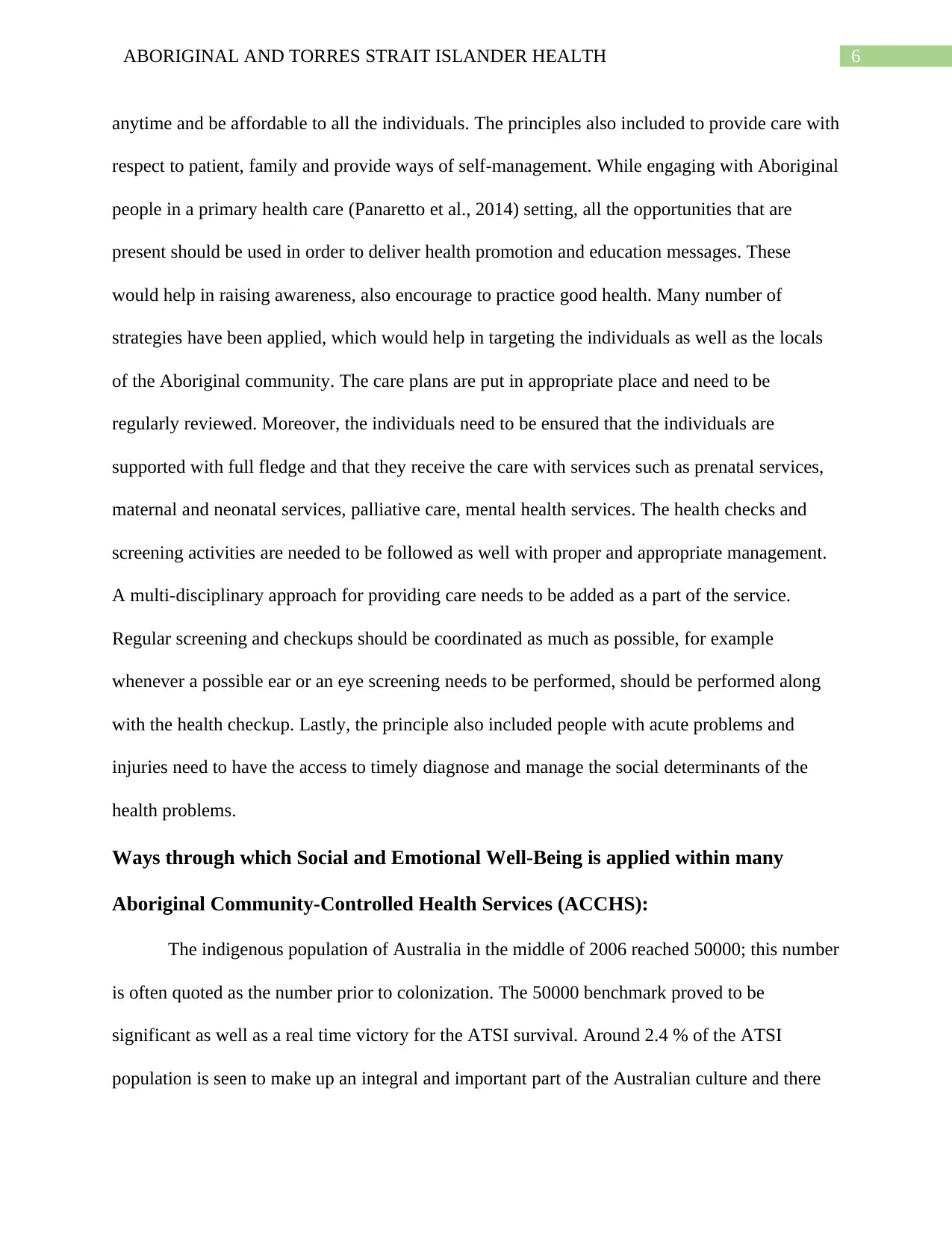
6ABORIGINAL AND TORRES STRAIT ISLANDER HEALTH
anytime and be affordable to all the individuals. The principles also included to provide care with
respect to patient, family and provide ways of self-management. While engaging with Aboriginal
people in a primary health care (Panaretto et al., 2014) setting, all the opportunities that are
present should be used in order to deliver health promotion and education messages. These
would help in raising awareness, also encourage to practice good health. Many number of
strategies have been applied, which would help in targeting the individuals as well as the locals
of the Aboriginal community. The care plans are put in appropriate place and need to be
regularly reviewed. Moreover, the individuals need to be ensured that the individuals are
supported with full fledge and that they receive the care with services such as prenatal services,
maternal and neonatal services, palliative care, mental health services. The health checks and
screening activities are needed to be followed as well with proper and appropriate management.
A multi-disciplinary approach for providing care needs to be added as a part of the service.
Regular screening and checkups should be coordinated as much as possible, for example
whenever a possible ear or an eye screening needs to be performed, should be performed along
with the health checkup. Lastly, the principle also included people with acute problems and
injuries need to have the access to timely diagnose and manage the social determinants of the
health problems.
Ways through which Social and Emotional Well-Being is applied within many
Aboriginal Community-Controlled Health Services (ACCHS):
The indigenous population of Australia in the middle of 2006 reached 50000; this number
is often quoted as the number prior to colonization. The 50000 benchmark proved to be
significant as well as a real time victory for the ATSI survival. Around 2.4 % of the ATSI
population is seen to make up an integral and important part of the Australian culture and there
anytime and be affordable to all the individuals. The principles also included to provide care with
respect to patient, family and provide ways of self-management. While engaging with Aboriginal
people in a primary health care (Panaretto et al., 2014) setting, all the opportunities that are
present should be used in order to deliver health promotion and education messages. These
would help in raising awareness, also encourage to practice good health. Many number of
strategies have been applied, which would help in targeting the individuals as well as the locals
of the Aboriginal community. The care plans are put in appropriate place and need to be
regularly reviewed. Moreover, the individuals need to be ensured that the individuals are
supported with full fledge and that they receive the care with services such as prenatal services,
maternal and neonatal services, palliative care, mental health services. The health checks and
screening activities are needed to be followed as well with proper and appropriate management.
A multi-disciplinary approach for providing care needs to be added as a part of the service.
Regular screening and checkups should be coordinated as much as possible, for example
whenever a possible ear or an eye screening needs to be performed, should be performed along
with the health checkup. Lastly, the principle also included people with acute problems and
injuries need to have the access to timely diagnose and manage the social determinants of the
health problems.
Ways through which Social and Emotional Well-Being is applied within many
Aboriginal Community-Controlled Health Services (ACCHS):
The indigenous population of Australia in the middle of 2006 reached 50000; this number
is often quoted as the number prior to colonization. The 50000 benchmark proved to be
significant as well as a real time victory for the ATSI survival. Around 2.4 % of the ATSI
population is seen to make up an integral and important part of the Australian culture and there
Paraphrase This Document
Need a fresh take? Get an instant paraphrase of this document with our AI Paraphraser
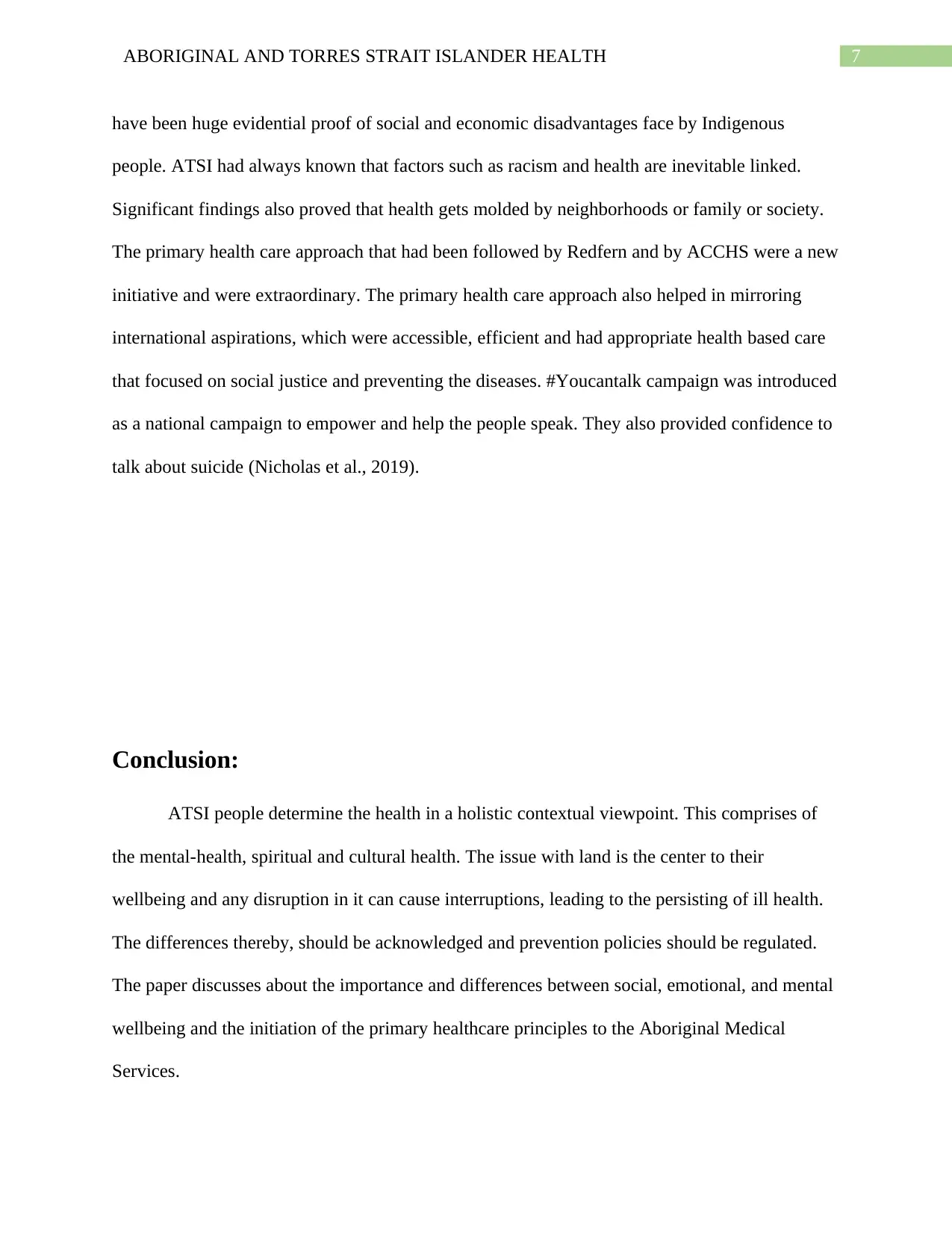
7ABORIGINAL AND TORRES STRAIT ISLANDER HEALTH
have been huge evidential proof of social and economic disadvantages face by Indigenous
people. ATSI had always known that factors such as racism and health are inevitable linked.
Significant findings also proved that health gets molded by neighborhoods or family or society.
The primary health care approach that had been followed by Redfern and by ACCHS were a new
initiative and were extraordinary. The primary health care approach also helped in mirroring
international aspirations, which were accessible, efficient and had appropriate health based care
that focused on social justice and preventing the diseases. #Youcantalk campaign was introduced
as a national campaign to empower and help the people speak. They also provided confidence to
talk about suicide (Nicholas et al., 2019).
Conclusion:
ATSI people determine the health in a holistic contextual viewpoint. This comprises of
the mental-health, spiritual and cultural health. The issue with land is the center to their
wellbeing and any disruption in it can cause interruptions, leading to the persisting of ill health.
The differences thereby, should be acknowledged and prevention policies should be regulated.
The paper discusses about the importance and differences between social, emotional, and mental
wellbeing and the initiation of the primary healthcare principles to the Aboriginal Medical
Services.
have been huge evidential proof of social and economic disadvantages face by Indigenous
people. ATSI had always known that factors such as racism and health are inevitable linked.
Significant findings also proved that health gets molded by neighborhoods or family or society.
The primary health care approach that had been followed by Redfern and by ACCHS were a new
initiative and were extraordinary. The primary health care approach also helped in mirroring
international aspirations, which were accessible, efficient and had appropriate health based care
that focused on social justice and preventing the diseases. #Youcantalk campaign was introduced
as a national campaign to empower and help the people speak. They also provided confidence to
talk about suicide (Nicholas et al., 2019).
Conclusion:
ATSI people determine the health in a holistic contextual viewpoint. This comprises of
the mental-health, spiritual and cultural health. The issue with land is the center to their
wellbeing and any disruption in it can cause interruptions, leading to the persisting of ill health.
The differences thereby, should be acknowledged and prevention policies should be regulated.
The paper discusses about the importance and differences between social, emotional, and mental
wellbeing and the initiation of the primary healthcare principles to the Aboriginal Medical
Services.
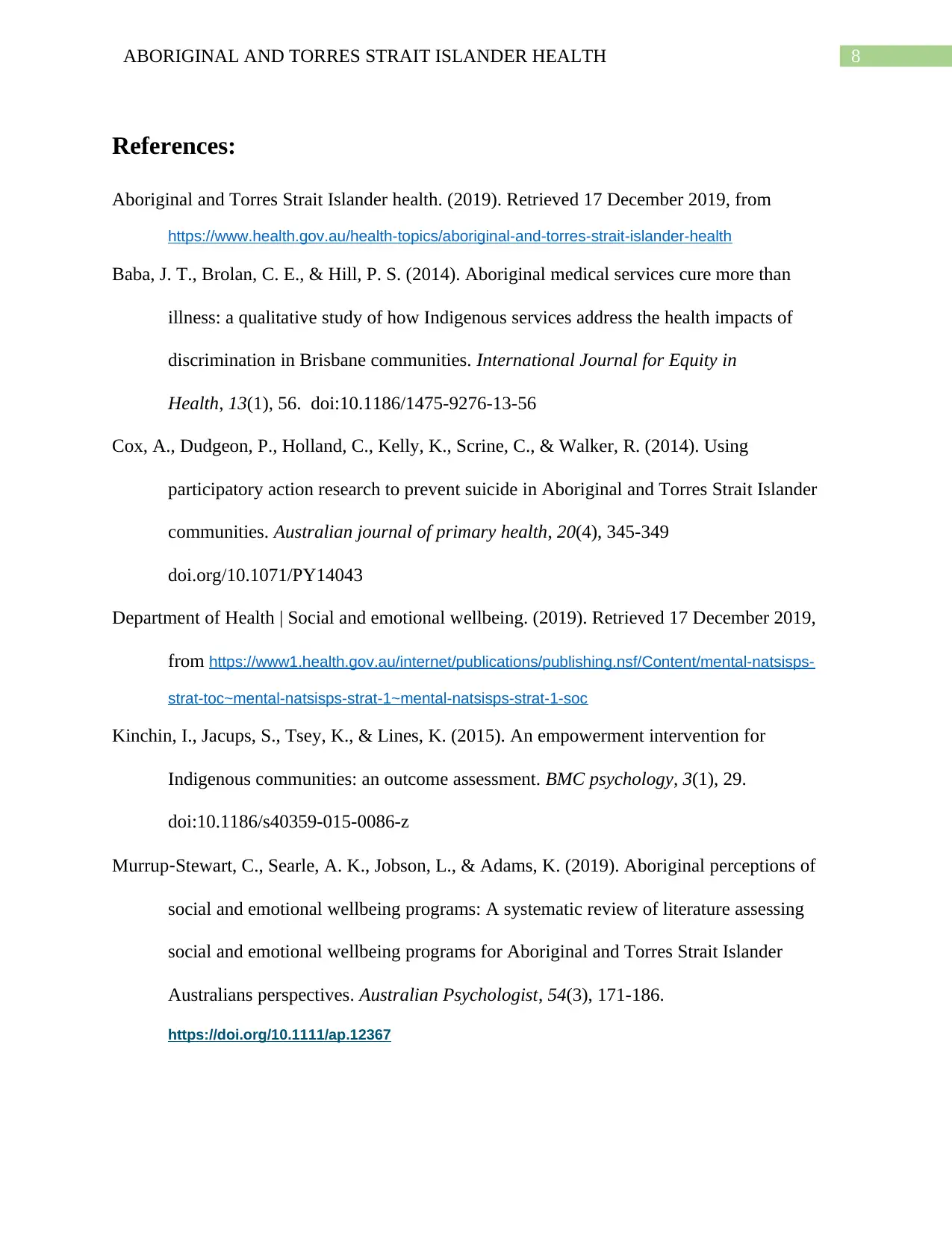
8ABORIGINAL AND TORRES STRAIT ISLANDER HEALTH
References:
Aboriginal and Torres Strait Islander health. (2019). Retrieved 17 December 2019, from
https://www.health.gov.au/health-topics/aboriginal-and-torres-strait-islander-health
Baba, J. T., Brolan, C. E., & Hill, P. S. (2014). Aboriginal medical services cure more than
illness: a qualitative study of how Indigenous services address the health impacts of
discrimination in Brisbane communities. International Journal for Equity in
Health, 13(1), 56. doi:10.1186/1475-9276-13-56
Cox, A., Dudgeon, P., Holland, C., Kelly, K., Scrine, C., & Walker, R. (2014). Using
participatory action research to prevent suicide in Aboriginal and Torres Strait Islander
communities. Australian journal of primary health, 20(4), 345-349
doi.org/10.1071/PY14043
Department of Health | Social and emotional wellbeing. (2019). Retrieved 17 December 2019,
from https://www1.health.gov.au/internet/publications/publishing.nsf/Content/mental-natsisps-
strat-toc~mental-natsisps-strat-1~mental-natsisps-strat-1-soc
Kinchin, I., Jacups, S., Tsey, K., & Lines, K. (2015). An empowerment intervention for
Indigenous communities: an outcome assessment. BMC psychology, 3(1), 29.
doi:10.1186/s40359-015-0086-z
Murrup‐Stewart, C., Searle, A. K., Jobson, L., & Adams, K. (2019). Aboriginal perceptions of
social and emotional wellbeing programs: A systematic review of literature assessing
social and emotional wellbeing programs for Aboriginal and Torres Strait Islander
Australians perspectives. Australian Psychologist, 54(3), 171-186.
https://doi.org/10.1111/ap.12367
References:
Aboriginal and Torres Strait Islander health. (2019). Retrieved 17 December 2019, from
https://www.health.gov.au/health-topics/aboriginal-and-torres-strait-islander-health
Baba, J. T., Brolan, C. E., & Hill, P. S. (2014). Aboriginal medical services cure more than
illness: a qualitative study of how Indigenous services address the health impacts of
discrimination in Brisbane communities. International Journal for Equity in
Health, 13(1), 56. doi:10.1186/1475-9276-13-56
Cox, A., Dudgeon, P., Holland, C., Kelly, K., Scrine, C., & Walker, R. (2014). Using
participatory action research to prevent suicide in Aboriginal and Torres Strait Islander
communities. Australian journal of primary health, 20(4), 345-349
doi.org/10.1071/PY14043
Department of Health | Social and emotional wellbeing. (2019). Retrieved 17 December 2019,
from https://www1.health.gov.au/internet/publications/publishing.nsf/Content/mental-natsisps-
strat-toc~mental-natsisps-strat-1~mental-natsisps-strat-1-soc
Kinchin, I., Jacups, S., Tsey, K., & Lines, K. (2015). An empowerment intervention for
Indigenous communities: an outcome assessment. BMC psychology, 3(1), 29.
doi:10.1186/s40359-015-0086-z
Murrup‐Stewart, C., Searle, A. K., Jobson, L., & Adams, K. (2019). Aboriginal perceptions of
social and emotional wellbeing programs: A systematic review of literature assessing
social and emotional wellbeing programs for Aboriginal and Torres Strait Islander
Australians perspectives. Australian Psychologist, 54(3), 171-186.
https://doi.org/10.1111/ap.12367
⊘ This is a preview!⊘
Do you want full access?
Subscribe today to unlock all pages.

Trusted by 1+ million students worldwide
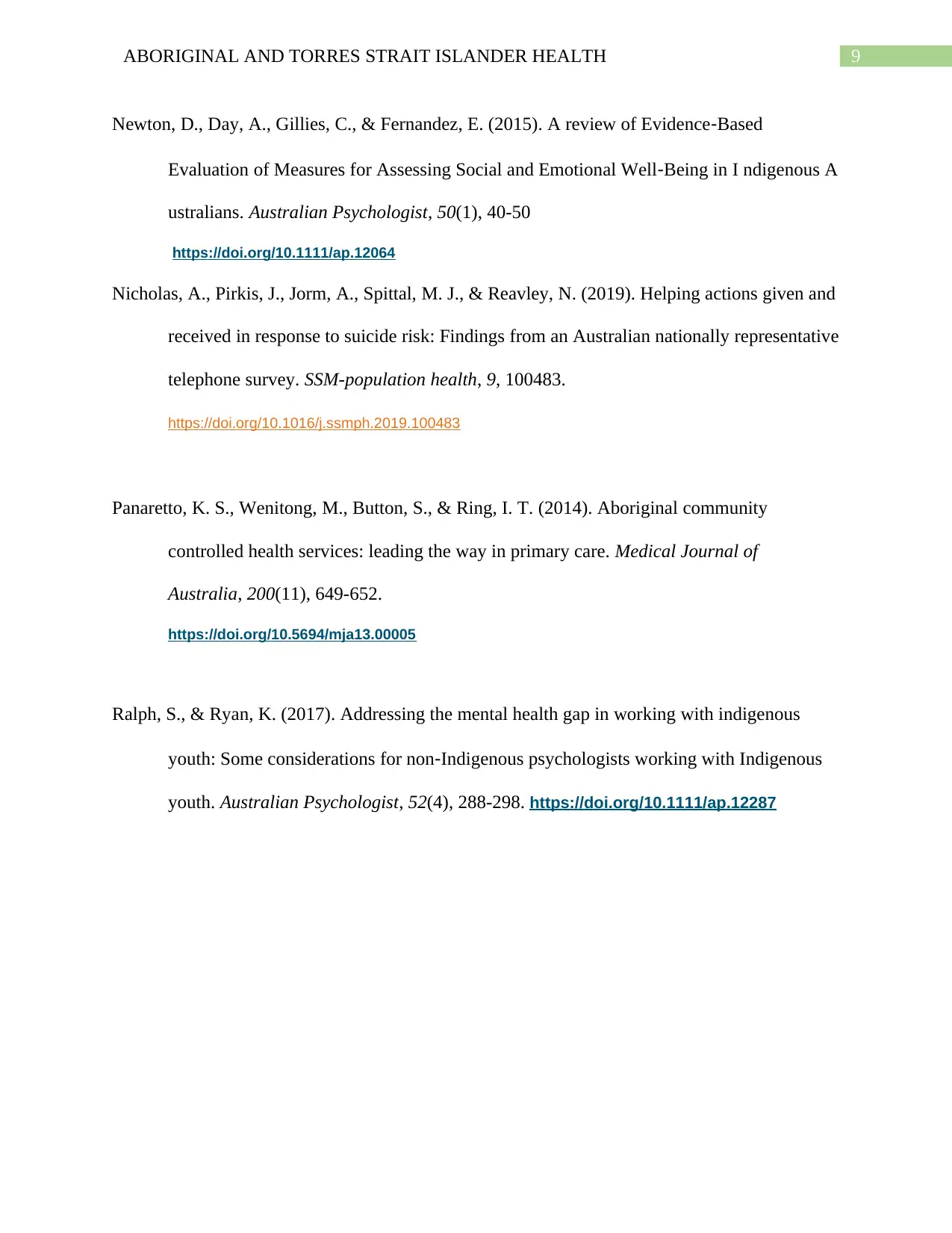
9ABORIGINAL AND TORRES STRAIT ISLANDER HEALTH
Newton, D., Day, A., Gillies, C., & Fernandez, E. (2015). A review of Evidence‐Based
Evaluation of Measures for Assessing Social and Emotional Well‐Being in I ndigenous A
ustralians. Australian Psychologist, 50(1), 40-50
https://doi.org/10.1111/ap.12064
Nicholas, A., Pirkis, J., Jorm, A., Spittal, M. J., & Reavley, N. (2019). Helping actions given and
received in response to suicide risk: Findings from an Australian nationally representative
telephone survey. SSM-population health, 9, 100483.
https://doi.org/10.1016/j.ssmph.2019.100483
Panaretto, K. S., Wenitong, M., Button, S., & Ring, I. T. (2014). Aboriginal community
controlled health services: leading the way in primary care. Medical Journal of
Australia, 200(11), 649-652.
https://doi.org/10.5694/mja13.00005
Ralph, S., & Ryan, K. (2017). Addressing the mental health gap in working with indigenous
youth: Some considerations for non‐Indigenous psychologists working with Indigenous
youth. Australian Psychologist, 52(4), 288-298. https://doi.org/10.1111/ap.12287
Newton, D., Day, A., Gillies, C., & Fernandez, E. (2015). A review of Evidence‐Based
Evaluation of Measures for Assessing Social and Emotional Well‐Being in I ndigenous A
ustralians. Australian Psychologist, 50(1), 40-50
https://doi.org/10.1111/ap.12064
Nicholas, A., Pirkis, J., Jorm, A., Spittal, M. J., & Reavley, N. (2019). Helping actions given and
received in response to suicide risk: Findings from an Australian nationally representative
telephone survey. SSM-population health, 9, 100483.
https://doi.org/10.1016/j.ssmph.2019.100483
Panaretto, K. S., Wenitong, M., Button, S., & Ring, I. T. (2014). Aboriginal community
controlled health services: leading the way in primary care. Medical Journal of
Australia, 200(11), 649-652.
https://doi.org/10.5694/mja13.00005
Ralph, S., & Ryan, K. (2017). Addressing the mental health gap in working with indigenous
youth: Some considerations for non‐Indigenous psychologists working with Indigenous
youth. Australian Psychologist, 52(4), 288-298. https://doi.org/10.1111/ap.12287
1 out of 10
Related Documents
Your All-in-One AI-Powered Toolkit for Academic Success.
+13062052269
info@desklib.com
Available 24*7 on WhatsApp / Email
![[object Object]](/_next/static/media/star-bottom.7253800d.svg)
Unlock your academic potential
Copyright © 2020–2025 A2Z Services. All Rights Reserved. Developed and managed by ZUCOL.




